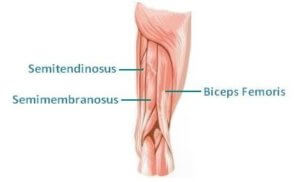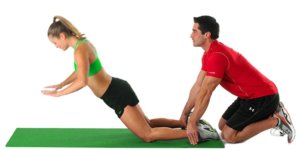
One of the most common injuries in sport is the hamstring strain, as the hamstring muscles are very susceptible to tears and strains in those sports that demand speed and agility. It is the most common injury in AFL and the dreaded ‘ping’ of the hammy has shortened many seasons and even careers.
The ‘hamstring’ is actually a group of three muscles, the Biceps Femoris, Semimembranosus and Semitendinosus.

Most hamstring injuries occurs due to excessive strain during the lengthening phase of contraction, causing fibres of the muscle to tear. This injury is graded according to severity, on a 3-point scale. A higher grade of injury correlates to a greater number of fibres torn.
Each individual’s symptoms can vary depending on the severity of their injury. Some may experience slight discomfort while others may be in significant pain and unable place weight on the injured leg.
Risk factors
Hamstring strain injuries generally occur playing sports where high speed sprinting and kicking are performed frequently.
There are a number of factors that can increase your risk of hamstring injury. The non-modifiable risk factors include age, race, and a past history of hamstring strain.
The modifiable risk factors and things you can work on include; a lack of muscle length, strength and flexibility, strength imbalance between limbs, fatigue, insufficient warm-up, poor running mechanics, and excessive training loads.
Research suggests that a Nordic hamstring curl exercise can target some of these modifiable risk factors to reduce your chances of re-injury.
Once you’ve overcome the acute stages of your hamstring injury, it is important to start strengthening exercises to rebuild the muscle; this is a valuable component of hamstring strain rehabilitation and prevention.
Hamstring injuries and sport
Research suggests that hamstring strain injury is the most common cause of loss of training and playing time in running-based sports.
If you are involved in similar sports, such as soccer and AFL; strength training is proven to be a valuable component of both hamstring strain prevention and rehabilitation.
A simple and effective way you can help to reduce your personal risk of hamstring injury or rehabilitate a pre-existing hamstring injury is to add one exercise into your current training program.
EXERCISE – Nordic Hamstring Curl
The Nordic Hamstring Curl [NHC] has proven benefits to increase length and strength of the hamstring complex.
There is strong evidence that a training program inclusive of the NHC decreases the risk of hamstring injury by up to 51% in the long term. This exercise has also been found to successfully reduce severity of hamstring injury.
HOW TO PERFORM:
This exercise is best performed with a partner.
- Kneel down on an exercise mat or comfortable surface with your knees bent at 90 degrees and your torso vertical
- Have your partner hold your ankles firmly to offer support
- Lean forward, slowly lowering your body to the floor trying to keep as vertical as possible. Aim to make your hamstrings do the majority of the work.
- Meet the ground with your hands and without pausing, pull yourself up from the floor using your hamstring strength and hands for assistance back to the start position.
- For best results, perform 2 sets of 6 repetitions twice a week (not on consecutive days).

THINGS TO REMEMBER:
- This exercise should be performed within a 0-4/10 intensity of pain.
- It is important that this exercise is not performed before a game or training session as it may cause further injury.
- You should continue this routine for 6-8 weeks.
- After the 6-8 week period has elapsed you can continue maintenance strengthening by performing 2 sets of 4 repetitions twice a week.
Returning to sport
If you’re yet to return to sport, it is important that you have progressed through light to moderate jogging with a noticeable acceleration and deceleration phase. This is designed to prepare you for the start/stop requirements of a sporting game.
Once this is comfortable, it is appropriate to commence sprinting and game-based training sessions at a suitable intensity.
If you’re having difficulty deciding when it’s appropriate to progress your rehabilitation program, an assessment may be helpful to accurately indicate your readiness to commence regular training and games. Book an appointment at Fusion Physiotherapy and your physiotherapist will be able to assist you in achieving a strong finish to your sporting season.
References:
Al Attar, W. S. A., Soomro, N., Sinclair, P. J., Pappas, E., & Sanders, R. H. (2017). Effect of injury prevention programs that include the nordic hamstring exercise on hamstring injury rates in soccer players: a systematic review and meta-analysis. Sports medicine, 47(5), 907-916. doi:10.1007/s40279-016-0638-2
Bourne, M. N., Timmins, R. G., Opar, D. A., Pizzari, T., Ruddy, J. D., Sims, C., … & Shield, A. J. (2018). An evidence-based framework for strengthening exercises to prevent hamstring injury. Sports Medicine, 1-17. doi:10.1007/s40279-017-0796-x
Evans, K., & Williams, M. (2017). The Effect Of Nordic Hamstring Exercise On Hamstring Injury In Professional Rugby Union. Br J Sports Med, 51(4), 316-317. Retrieved from https://bjsm-bmj-com.ez.library.latrobe.edu.au/content/bjsports/51/4/316.3.full.pdf
Liu, H., Garrett, W. E., Moorman, C. T., & Yu, B. (2012). Injury rate, mechanism, and risk factors of hamstring strain injuries in sports: A review of the literature. Journal of Sport and Health Science, 1(2), 92-101. Retrieved from https://doi.org/10.1016/j.jshs.2012.07.003

